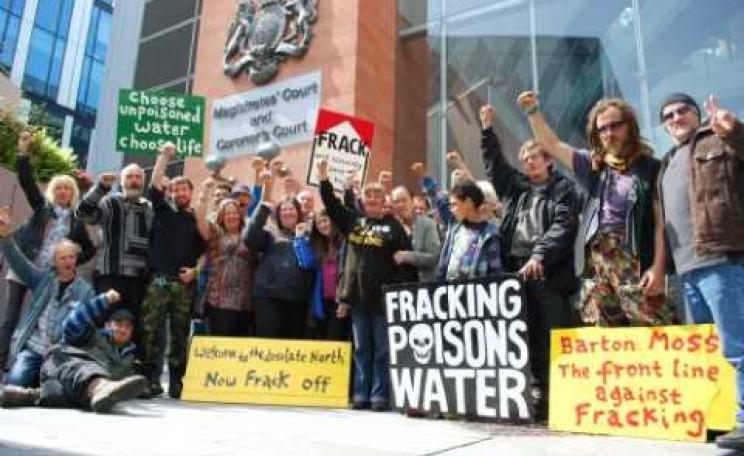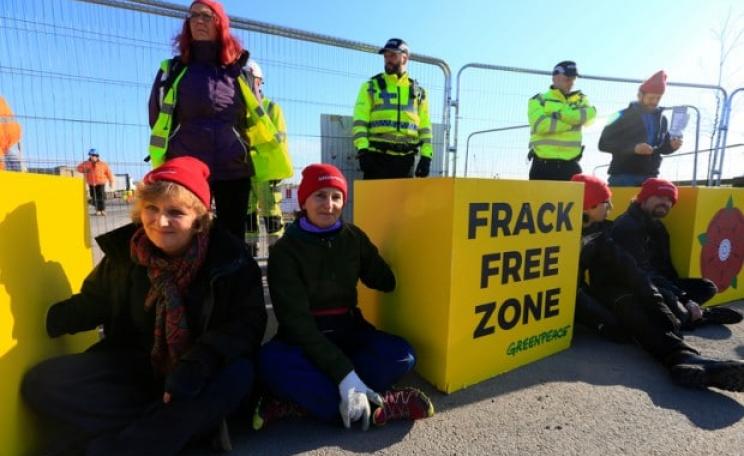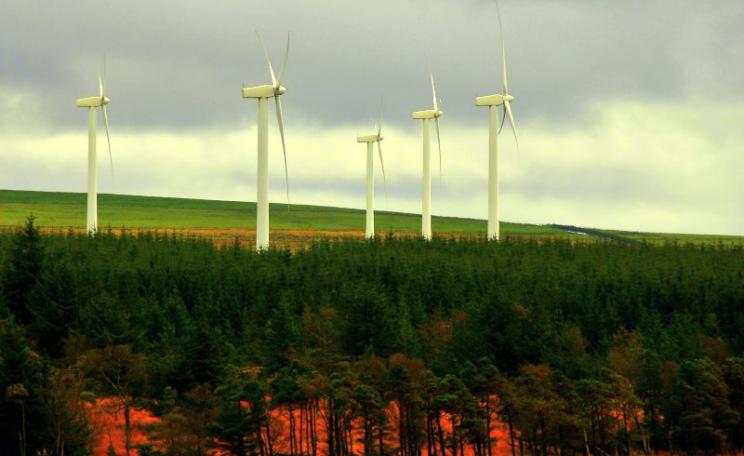If these renewable resources were to enjoy the same level of government support as fracking they would provide more new jobs and reduce energy costs lower than fracking could ever achieve.
In his budget today, George Osborne announced his continued support for the fossil fuel industry, North Sea oil and gas in particular.
But the budget document also found room to support shale gas - 'fracking' to you and me:
"The government believes in making the most of the UK's oil and gas resources, including the safe extraction of shale gas.
"Building on action set out in the March Budget 2015, the government will expand the North Sea investment and cluster area allowances to include additional activities which will maximise economic recovery."
The relatively small mention of shale gas may reflect the difficulties that face the UK's fracking industry. At the end of last month, Lancashire County Council refused Cuadrilla planning permission to explore two sites for natural gas.
And the fact that Conservative and Labour councillors joined to defeat the application, with considerable popular backing, shows that things are not all going the industry's way - nor indeed the Government's.
But while the government has been making strenuous efforts to ease the path of the frackers, new and rapidly expanding sources of biomethane and heat energy are already delivering all over the UK. They are far more safe and sustainable, with less environmental impact and much smaller carbon emissions than fracking - and clearly demonstrate that fracking is unnecessary.
If these renewable resources were to enjoy the same level of government support - both political and financial - as natural gas and fracking they would provide even more new jobs than they are already doing and reduce energy costs lower than fracking could ever achieve.
Ground source and air source heat pumps
The first alternative is to heat domestic buildings using ground source or air source heat pumps - in effect, refrigerators running in reverse, to cool the outside and warm the inside. The ground source approach uses the heat energy from the sun that is stored a few metres below ground. Air source systems take heat energy from the atmosphere.
Heat pumps have been pioneered in Sweden where most of their new-build houses are warmed by heat pump technology, using electricity as the power source. And of course, if the electricity comes from an all-renewable supplier then this form of heating is almost carbon free in operation.
Typically around three times as much of the 'free heat energy' (underground or in the air) is pumped into the building as the electrical energy the pump consumes. So for every kilowatt-hour of electricity consumed in the heat pump, you can expect to get four kilowatts hours of heat.
If the heat pump rating is insufficient for a building, or insulation is poor, performance suffers. Heat pumps are therefore ideal for well-designed new build houses. They are also the best solution for many buildings with no gas supply - and all the more so if they are currently heated electrically, as the heating bill will immediately drop by as much 75%.
If these renewable resources were to enjoy the same level of government support as fracking they would provide more new jobs and reduce energy costs lower than fracking could ever achieve.
Since there are a great many such homes in the UK, it would make excellent sense to roll out an accelerated programme of heat pump installation. Subsidies are available at present under the Renewable Heat Incentive, but take up remains low - so there's huge scope for expansion.
Shallow geothermal heat storage
The second approach also uses heat pumps, but boosted by using underground rocks as a heat store to save up the summer's heat for winter. The latest drilling technology allows boreholes to be sunk vertically and then splay out at an angle, much deeper than for ground source systems but a lot shallower than fracking wells.
At around 200 metres, around one tenth of the typical depth of shale gas, the rock makes an ideal heat store at a higher temperature than near the surface, thanks to both geothermal energy from the Earth's core, and the insulating effect of rock.
Using this underground thermal store, heat pumps can be used to heat a large building in winter (in the process cooling the heat store), and to remove excess heat from the building particularly air conditioning in summer (warming the heat store).
Due to the drilling cost this approach is best suited to large buildings such as big office buildings, shopping centres, sports complexes and hospitals, or entire estates of homes - provided that the heating and cooling requirement roughly balances over the annual cycle. Again, if the electricity for the heat pumps comes from a renewable supplier, the whole cycle will be much lower carbon than burning natural gas.
There has been little publicity for the fact that Geoscart has begun drilling in this way under the car parks of a leading supermarket chain, Sainsbury's, to develop geothermal heat storage systems at an initial 15 of 100 stores scheduled to receive the technology.
The heat pump systems are impressive, heating the store in winter, providing air conditioning in summer, and keeping the all-important freezer cabinets running efficiently. The waste heat, from the air-conditioning in summer and the freezer cabinets all year, is stored underground. Hence this technology is sustainable indefinitely.
By contrast, at many US sites, new fracking boreholes are having to be drilled as the yield from the original well drops. The Geoscart approach can be used in any building where recycling of waste heat is possible, for example from air conditioning, computers or manufacturing.
Biomethane from waste
The third alternative is biogas, also known as biomethane, for both electricity generation and the gas grid, arising from a number of sustainable and indigenous sources. They all have a far lower carbon footprint than natural gas.
Examples are biomethane produced from farm and food waste by anaerobic digestion (AD) and from sewage and landfill waste. One reason for the far lower greenhouse gas emissions of biomethane compared to natural gas is that biogas generated from waste avoids the inevitable greenhouse gas release were the waste left to rot in on the farm or in landfill.
In contrast to fracking, AD plants are, at last, up and running and expanding fast in the UK, though they still have some way to go to catch up with Germany. The hardback edition of The Burning Answer: a User's Guide to the Solar Revolution, describes the first AD plant to supply biomethane to the UK gas grid in 2012.
By the time the paperback edition came out in July 2015, 28 plants were in operation capable of injecting into the grid enough biomethane to heat 100,000 UK homes. By 2016 there should be sufficient biomethane for the companies that supply all-renewable electricity, like Ecotricity and Good Energy, to also offer customers biomethane.
All three of these alternatives could expand faster and generate cheaper energy if some of the current massive government subsidies for natural gas (larger than for all the renewables together) were switched to these technologies.
The environmental impact of shale gas
The battles over fracking have mainly been concerned with the local environmental impact. Reports from the US describe examples of chemical contamination of water supplies and radioactivity above acceptable levels in waste water and in the air in buildings.
There has been less public discussion about the impact of fracking on global warming. The majority of scientists accept that to avoid the most dangerous consequences of global warming we should not burn more than a third or so of proven fossil fuel reserves. Exploring for new natural gas resources with high carbon footprint and unproven yield is environmentally irresponsible.
In terms of carbon emissions, any leaks during the fracking process will release methane into the atmosphere. Methane is a far worse greenhouse gas than carbon dioxide. Researchers from Cornell University have shown that, even at the lowest leakage rates achieved in the USA, the carbon footprint of fracking is higher than coal burning.
And even if, by some miracle, zero methane leaks were achieved in the UK, the carbon footprint of electricity generation from fracked natural gas would still be over 40 times higher than electricity generation by biomethane from AD.
Why is the government so keen on fracking?
The Environmental Audit Committee has recommended a moratorium on fracking. The government's financial advisors, Mott-MacDonald, point out that biogas from sewage and landfill waste generates cheaper electricity than natural gas.
The National Grid observes that half the UK domestic gas could be supplied from waste by 2020. The Climate Change Committee has recommended a carbon limit that implies all our electricity supply should be renewably generated by 2030.
It is unlikely that fracking is a vote winner. The Department for Energy and Climate Change (DECC) has run surveys that show the support for shale gas is only 29%. By contrast the support for renewable technologies like onshore wind (70%) and photovoltaics (85%) is much higher.
Fully twice as many respondents (59%) are "happy to have a large scale renewable energy development in my area" as support fracking. DECC did not ask respondents if they would like fracking in their own neighbourhood. The support for fracking would surely have fallen even further had they done so.
Traditionally many farmers are Conservative supporters. Were a small part of the natural gas subsidy diverted to give more support to AD many farmers would be encouraged to utilise their waste this way.
In addition to biogas, another product of this process is a liquid fertiliser the farmers can use on their land - reducing their need for bought-in fertilisers, bringing further benefits in terms of reduced mining and reduced fossil fuel burn to produce synthetic nitrate.
Is the government paying too much attention to the fossil fuel lobby and to the advisors they have co-opted from that industry? So it would seem.
It's not for me to judge why that should be the case, but it's hard to avoid the suspicion that it's a combination of an outmoded world view among Cabinet members, irrational prejudice, 'old boy' networks of influence across government and fossil fuel companies, and influential party donations.
But whatever the reasons, if we are to reduce our carbon emissions it is high time they listened to majority public opinion - not that of influential vested interests.
Keith Barnham is Emeritus Professor of Physics at Imperial College London and author of 'The Burning Answer: a User's Guide to the Solar Revolution', (Weidenfeld & Nicolson).
More information at Burning Answers.







